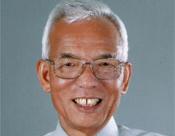In the early 1960's, we developed a radiative-convective model of the atmosphere, and explored the role of greenhouse gases such as water vapor, carbon dioxide and ozone in maintaining and changing the thermal structure of the atmosphere. This was the beginning of the long-term research on global warming, which I have continued until now in collaborating with the staff members of Geophysical Fluid Dynamics Laboratory (GFDL) of NOAA.
In the late 1960's, Kirk Bryan and I began to develop a general circulation model of the coupled atmosphere-ocean-land system, which eventually became a very powerful tool for the simulation of Global warming. Furthermore, we have realized that a coupled model simulates well the low frequency variability of climate. This has encouraged us to use a coupled model for exploring not only global warming but also unforced, natural variability of climate from seasonal to centennial time scales.
The analysis of deep sea sediments and continental ice sheets indicates that the Earth’s climate has fluctuated greatly during the geological past. Throughout my career, past climate changes have posed many challenging questions, which we have tried to answer using climate models with various complexity.
In the late 1960's, Kirk Bryan and I began to develop a general circulation model of the coupled atmosphere-ocean-land system, which eventually became a very powerful tool for the simulation of Global warming. Furthermore, we have realized that a coupled model simulates well the low frequency variability of climate. This has encouraged us to use a coupled model for exploring not only global warming but also unforced, natural variability of climate from seasonal to centennial time scales.
The analysis of deep sea sediments and continental ice sheets indicates that the Earth’s climate has fluctuated greatly during the geological past. Throughout my career, past climate changes have posed many challenging questions, which we have tried to answer using climate models with various complexity.

